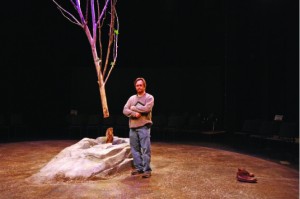A day in the life of a scene designer and technician

By: Clinton Borror
-Staff Writer-
Audience members enter the theater and find their seats encircling a dead tree. There is little on the stage but a dead tree. The lighting goes low and the tree seems to glow, the light shining off it like polished ivory.
The man responsible for designing this set is scene designer and technician Darren Thompson. Thompson designs the scenes for two of the four plays presented in Meramec’s theater each year. In 2005, Thompson undertook a two-week fellowship with Ming Cho Ling and Constance Hoffman and has recently been awarded the 2010 Kennedy Center National Teaching Artist Grant in Lighting Design.
Meramec’s other two plays are designed by theater manager and scene designer Richard Willmore. When Willmore designs scenes, Thompson designs props, and vice versa.
Willmore said Thompson has a talent for bringing a play’s concept out.
“He can draw, plan and explain his ideas. He knows how to explain the director’s concept. He knows how to bring that concept out,” Willmore said.
During his early years in college, Thompson’s primary interest was acting.
“I wanted to work originally. I got to about my junior year and realized ‘I don’t think anybody is beating down my door to cast me,’ so I started thinking more along the lines of being a technician,” Thompson said.
After reading each play, the director must determine a generic view of what the play scenes will be like, frequently consulting the scene designer. Once this is determined, Thompson begins a preproduction process.
“For me, the earlier I begin, the better. Right now I am already started on next year’s play,” Thompson said.
After preproduction, Thompson starts the research phase.
“You do this through meetings with the director and research, both online and in the real world,” said Thompson.
Thompson said that the next step in production is sketching the drawing.
“You’re sketching. You’re meeting with the director. You’re drawing at work. You’re drawing at home. Any idea that comes, I take it,” Thompson said.
Thompson said that after several drawings, a better view of the play is formed for those involved.
“Finally, I get to the point throughout various production meetings where you find what some people call ‘the world of the play.’ What that is, not only the physical environment but what the play is trying to get across,” Thompson said.
Thompson said that a computer-aided drawing phase helps his set come to life.
“I try to create it in real life. On a computer, I can do that very fast. I can change it up. I can show the director what it looks like from almost any seat in the house. After the computer model is done, then it’s working with real models,” Thompson said.
His next step is the construction of the set itself, some of which is built by Thompson. He works with shop foreman John Houston to build scenes, he shares his goals through models, drawings, and computer-aided imagery so Houston can determine what is possible to build.
Thompson said that Houston is a very talented shop foreman.
“He is obviously very creative, but he is smarter than he gives himself credit for. I never do anything without the approval of the shop foreman. If he can’t build it, it won’t do any good. I’ve given him some difficult work which he’s pulled off extraordinarily,” Thompson said.
A scene designer’s job also includes researching paint, texture and lighting, instructing some aspects of scene production the moment it is being produced, and doing several other unmentioned activities. The next step is the lighting design phase. Thompson said that lighting design involves everything in the physical set design.
“I know the design. The design is mine, so I will sculpt the design by placing lights around it,” Thompson said.
Thompson described the last phase of his duties as a technician and scene designer, before the show begins.
“Finally, you get into the technical process where you are actually making the show happen. We usually do a week of technical work, which means that everyone is working from eight in the morning till midnight. In day you finalize the set and at night you rehearse the show,” Thompson said.
Design is something Thompson has always been passionate about.
“I have always loved designing. I have always thought it to be an art,”
Thompson said.











